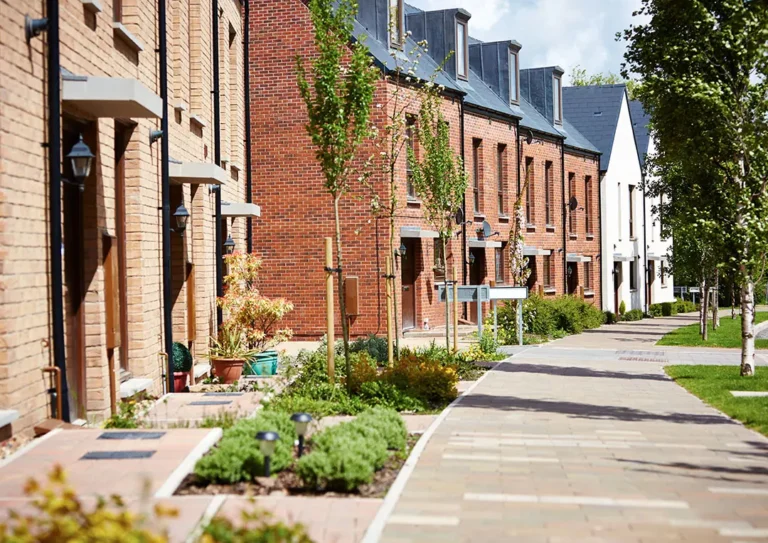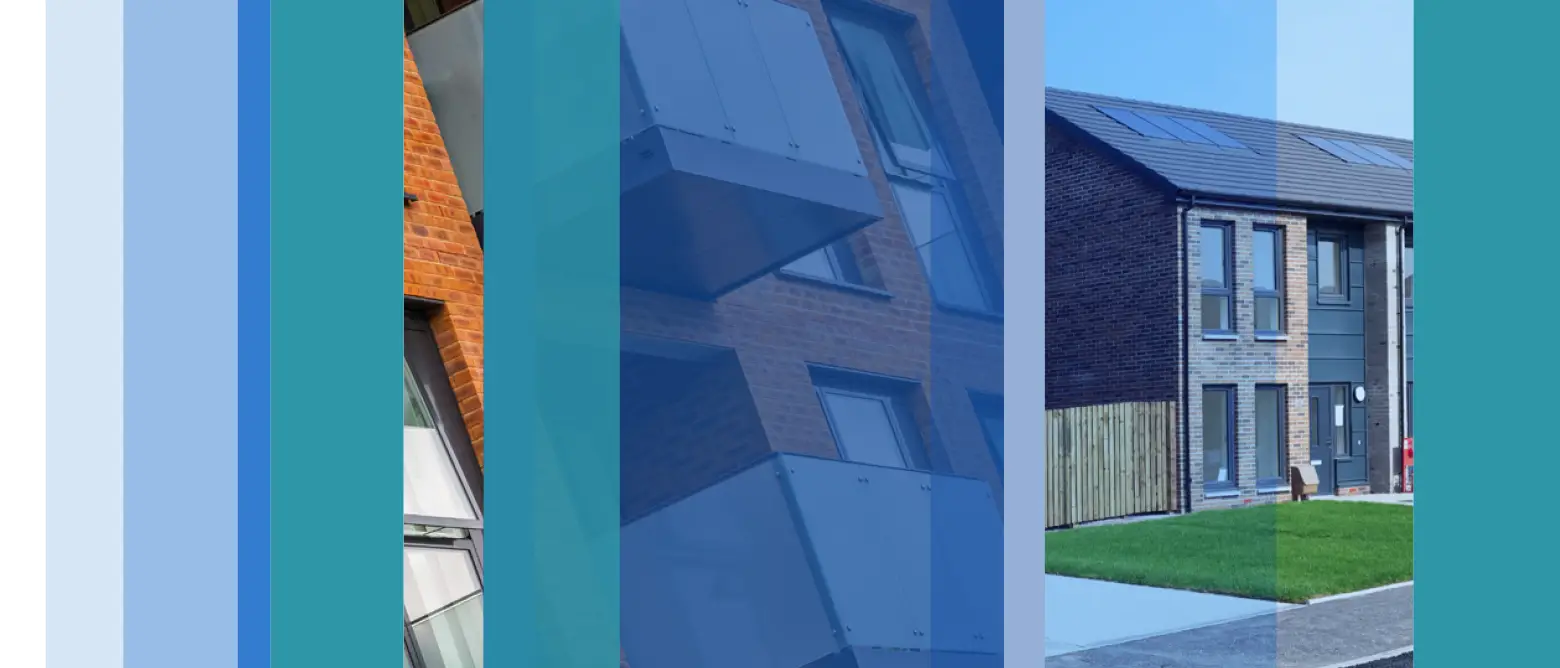
Social housing accounts for more than 28 million dwellings across OECD countries.1 On average, it makes up 7% of the total housing stock in OECD countries, and in excess of 20% of the total housing stock in countries such as Austria, Denmark and the Netherlands.2
Whilst sustainable finance products have the potential to deliver and highlight significant sustainability improvements across a wide range of sectors, the use of these products in the social housing sector has provided a unique opportunity to deliver meaningful change across a spectrum of environmental, social and governance (ESG) issues.
Sustainable lending products can, for example, be used to help channel finance towards improving the environmental sustainability of existing social housing stock (for example, upgrading insulation, looking at alternative sources of heat or installing renewable energy systems or reducing water consumption). Improving the environmental sustainability of existing social housing stock can also result in significant social benefits – by delivering cost savings to the social housing tenant through reduced energy consumption or water bills; improved accessibility; and/or the improvement of air quality and living conditions.

This article focuses on the potential benefits of the use of green, social, and sustainability-linked loans in the social housing sector, and explores some of the related challenges and opportunities for market participants.
Green Loans
The Global Sustainable Investing Alliance has valued the sustainable finance market world wide at USD35.3trillion3 and rising. ESG considerations are now top of the agenda for lenders due to increased stakeholder interest in ethical and sustainable investments as well as regulatory pressure to report on the ESG performance of loan/bond portfolios and investments generally. This has led to investors enthusiastically embracing ESG and lenders developing numerous forms of sustainable finance products for market. These include green, social and sustainablity-linked loans.
As set out in more detail in the Green Loan Principles4 (GLP), green loans have four core components which should be carefully adhered to: –
- use of proceeds – the fundamental determinant of a green loan is the utilisation of the loan proceeds for Green Projects (as further described in the GLP);
- process for project evaluation and selection;
- management of proceeds; and
- reporting.
In the social housing sphere, green use of proceeds loans have typically been used to improve the environmental efficiency of a housing provider’s residential stock often demonstrated by improving the overall Energy Performance Certificate (EPC) rating of their housing stock (for example, to get from EPC rating C to B). The aim is typically to improve environmental performance, thereby working towards carbon neutrality and with the added benefit of reducing the burden of costly utility bills for often vulnerable tenants. Housing providers can improve the environmental efficiency of their stock in several ways, including identifying sources of heat loss and installing renewable energy systems.
Housing providers have also used proceeds from green loans to fund pilot retrofit schemes. Full scale retrofit in the UK is still at the pilot stage owing to the difficulty in passing retrofit costs on to affordable housing tenants in a cost-of-living crisis. Where implemented, housing providers generally take a “fabric first” approach to retrofitting stock to achieve carbon neutrality. A fabric first approach aims to reduce the demand for heat and power in any housing unit by improving insulation and ventilation, installing alternative sources of heat (for example, heat pumps and heat loops) and installing renewable energy systems, such as solar panels.
Proceeds from green loans have also been used by housing providers to install charging ports for electric cars. With the requirement in the UK (mandatory from January 2024) that new housing developments must show a 10% biodiversity net gain to obtain planning permission, housing providers may look to green use of proceeds loans to assist with funding their biodiversity objectives in the future.
Social Loans
Social loans, designed with a focus on social impact, have also proven to be popular in the social housing sector. In accordance with the Social Loan Principles5 (SLP),the proceeds of asocialloan must be used for Social Project(s) to a target population. There is no agreed definition of a Social Project, but a non-exhaustive, indicative list is included in the SLP which includes affordable housing and employment generation. While social housing providers can often have a positive environmental impact, they arguably have an even stronger story to tell when it comes to the social dimension of ESG. Social housing providers may not always be able to improve the energy efficiency of all their stock due to the age of the stock or limitations on changing the fabric of the buildings (such as listed properties), but they can undertake projects that will have a beneficial social impact on their tenants and the communities they live in.
Social impact is baked into social housing providers’ DNA. It is what they do – they provide affordable housing to those in need and help their tenants with a variety of financial, social and wellbeing needs. While social impact is harder to quantify in terms of measurable, benchmarkable data, social loans play a key role in helping social housing providers build stronger communities. Proceeds from social loans in the sector have been used to accelerate the delivery of affordable housing across the country. Funding from social loans has also been used by housing providers to build and maintain community gardens, fund financial literacy schemes, provide services to reduce inequalities and the funding and implementation of wellbeing schemes aimed at improving the health and wellbeing of staff members and tenants.
Quantitative and qualitative performance indicators are helpful in measuring social value, but the lack of a standardised approach (so far) to measuring social value means that it can be difficult to achieve transparency on the methodology and assumptions used in this area. While it is accepted that the consideration of social impacts should be an intrinsic part of decision making in businesses, it is acknowledged that measuring the beneficial impact of social initiatives is tricky. Some voluntary standards already exist in the market, but perhaps in due course the ISSB or other reporting standards will evolve to provide a consistent methodology for measuring social impact in relation to social housing.
Sustainability-Linked Loans
The most popular ESG-related financial product in the social housing sector to date has been sustainability-linked loans (SLLs). The attraction of SLLs is that the proceeds from the loans can be used by borrowers for any purpose (subject to any restrictions agreed by the parties and provided the result is an improvement in the borrower’s sustainability profile), and therefore SLLs give borrowers greater flexibility in their financial planning when compared to use of proceeds instruments. SLLs support the improvement of a borrower’s sustainability profile through the alignment of loan terms to borrower performance.
SLLs have skyrocketed in popularity in the social housing sector due to their flexibility. They are seen as a useful transition tool to support housing providers’ sustainability strategies. The product has evolved significantly in a relatively short period of time. Early SLLs in the sector often featured an agreement that the key performance indicators (KPIs) and/or SPTs would be negotiated later (and the loan could not be held out to be a sustainability-linked loan until they were in place). However, the Guidance on the Sustainability-Linked Loan Principles (as updated in February 2023) now provides that these so-called ‘sleeping SLLs’ are to be used only in exceptional instances and in any case be converted into SLLs within 12 months. 6
TheSustainability-LinkedLoanPrinciples(SLLP)7 require, amongst other things, that the KPIs and the overall sustainability strategy of the borrower must be credible so as not to undermine investor confidence in the product. The borrower should provide a clear definition of their KPIs, including the relevant scope or parameters, as well as the calculation methodology.
Example KPIs used in SLLs in the sector include, but are not limited to:
Environmental KPIs:
- Improving the Standard Assessment Procedure (SAP) rating of a providers residential properties year on year
- Improving the average of the EPC of the housing providers’ properties
- Increasing the amount of electric charging ports for electric cars
Social KPIs
- Aiding social housing tenants into paid employment
- Reducing the number of rough sleepers and those in temporary accommodation
Governance KPIs
- Improving the percentage number of the members of the governing body and executive team who are of African or Caribbean heritage, Asian or minority ethnic origin
- Improving the percentage number of female board members
- Reducing the median gender pay gap
The SLLP also require that the SPTs be set in good faith and remain both relevant and ambitious throughout the life of the loan. Careful consideration must therefore be given to the calibration of the SPTs by the parties to an SLL.
It will be interesting to see how SLLs evolve further in this sector. To meet their own regulatory requirements, lenders will likely need a more granular level of detail on ESG matters than ever before, and borrowers will be increasingly expected to fulfil those data requests. Housing providers are used to providing data on their social rented accommodation on a cyclical basis and may now find that information needs to be provided more regularly. There may also be more focus on science-based targets which, in turn, may mean that more external consultants will be required and there will need to be an upskilling of existing employees. In addition, biodiversity is an untapped area for KPIs in this sector and is likely to be a key area of focus going forward.
Finally, as KPIs and SPTs come under increasing scrutiny in the market, there is a growing concern that lenders and borrowers are now taking a cautious approach in relation to sustainable finance products due to concerns over greenwashing (or social-washing), and that this could be stifling innovation in the sector. The extent to which the market is able to respond to such concerns and further innovate to achieve sustainability goals remains to be seen.

Benchmarks and Verification
Underpinning SLL products is the mandatory requirement for benchmarkable data and third-party verification of the borrower’s performance against each SPT for each KPI.
The mandatory requirement for external verification under the SLLP was introduced as a safeguard to prevent borrowers marking their own homework and was therefore aimed at protecting the integrity of the SLL product. Nonetheless, it must be acknowledged that there can be challenges to obtaining verification. The data underpinning the metrics needs to be sound and this is a challenge facing all organisations as they search for the correct approach, technological or otherwise to data collection. In the housing sector many borrowers of sustainable finance products have opted to have their auditors sign off on their ESG metrics. However, the scarcity of auditors/verifiers serving this sector is a known issue.
In the social housing sector, housing providers have recognised the need for benchmarkable data and came together (with lenders and sector experts) to produce the Sustainability Reporting Standard for UK Social Housing (SRS). 8 Launched in November 2020, the SRS has been a game changer for the sector, providing a framework for consistent, comparable, and transparent reporting by housing providers on their sustainability performance. The SRS has been adopted by housing providers owning close to 2.2 million homes in the UK and is used by many more who have not yet formally adopted the SRS. The SRS is a voluntary framework made up of 48 ESG criteria split across 12 different themes which housing providers will report against on an annual basis. The SRS was developed after concerns that lenders were asking housing providers to answer ESG questionnaires which were not sector specific and did not adequately reflect the good performance of the social housing sector on ESG issues. A second iteration of the SRS was published in October 2023 following a consultation period with interested stakeholders.
The Annual Review published in June 2023 by Sustainability for Housing (who steward and develop the SRS) based on feedback from surveys and stakeholder interviews highlighted that housing providers reporting against the SRS made it easier for funders to work with them, with 63% of the funders who responded noting that it helped strengthen their relations with their housing provider borrowers. 9 The SRS is also driving change in the sector with 57% of respondents stating that the SRS had accelerated the implementation of their planned ESG activities. Having a sector specific set of criteria for benchmarking ESG performance is vital to driving the growth of sustainable finance products and accelerating the pace of ESG-related change in the sector.
Conclusion
The integration and adoption of sustainable finance products in the social housing sector is proving to be a catalyst for a just transition towards a more sustainable and equitable future. These innovative financial instruments not only align the finance with sustainability considerations, but also generate a multitude of positive outcomes. We know that climate change and climate adaptation are key areas that need to be tackled by the built environment and green, social and sustainability-linked loans help to provide housing providers with the funding they need to retrofit existing properties, develop sustainable infrastructure, reduce carbon emissions, and lower energy bills (and therefore living costs) for their tenants.
Social housing providers have an excellent story to tell in relation to the social dimension of ESG and they continue to build safe, affordable, and inclusive living communities. For SLLs, the use of environmental KPIs tends to be more common due to the difficulties faced when measuring social or governance aspects of ESG, however this is likely to change as ESG initiatives in the sector evolve.
While there are challenges in relation to data collection and verification, they are far outweighed by the positive outcomes of adopting sustainable finance products in the social housing sector. As we continue towards a just transition, it is evident that the fusion of financial innovation and social and environmental responsibility is a necessity. The use of sustainable finance products (as demonstrated by their use in social housing in the UK) can help to drive positive behavioural change and the acceleration of ESG initiatives.

- https://www.oecd.org/els/family/PH4-2-Social-rental-housing-stock.pdf
- As above
- GSIR-20201.pdf(gsi-alliance.org)
- https://www.lma.eu.com/guides/green-loan-principles
- https://www.lma.eu.com/guides/social-loan-principles
- SLLP_Guidance_23_February_2023_v.2.pdf (lma.eu.com)
- https://www.lma.eu.com/guides/sustainability-linked-loan-principles
- Autumn-2023-SRS-Criteria-v2.0.xlsx (live.com)
- 2nd Annual Review – June 2023 – Sustainability for Housing



